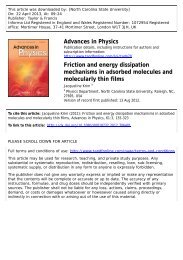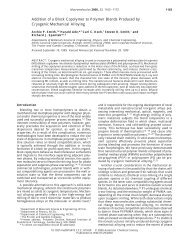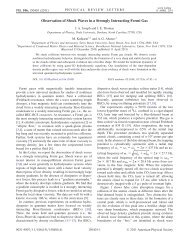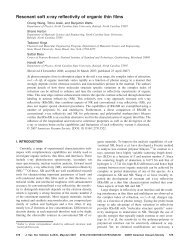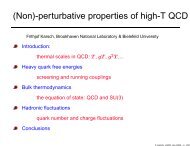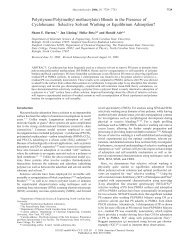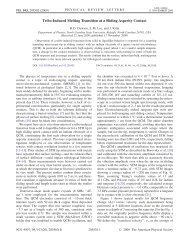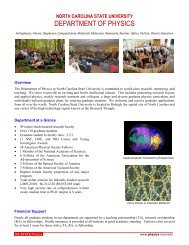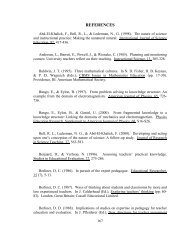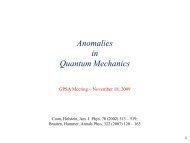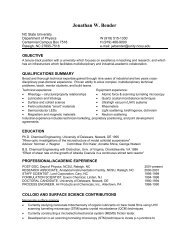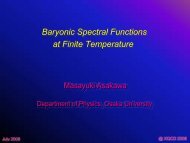Phys. Rev. Lett. 102, 250402 (2009): Inelastic Collisions of a Fermi ...
Phys. Rev. Lett. 102, 250402 (2009): Inelastic Collisions of a Fermi ...
Phys. Rev. Lett. 102, 250402 (2009): Inelastic Collisions of a Fermi ...
You also want an ePaper? Increase the reach of your titles
YUMPU automatically turns print PDFs into web optimized ePapers that Google loves.
PRL <strong>102</strong>, <strong>250402</strong> (<strong>2009</strong>) PHYSICAL REVIEW LETTERS<br />
week ending<br />
26 JUNE <strong>2009</strong><br />
resonance at B ¼ 877 G, we find K 3 ¼ 3:5 0:9 <br />
10 28 cm 6 =s at hx 2 i=x 2 F ¼ 1:9 and K 3 ¼ 1:9 0:3 <br />
10 28 cm 6 =s at hx 2 i=x 2 F ¼ 0:8. In this case, K 3ðhx 2 i=<br />
x 2 F ¼ 1:9Þ=K 3ðhx 2 i=x 2 F<br />
¼ 0:8Þ ¼1:8 0:6, while the<br />
ratio <strong>of</strong> the mean square widths is 1:9=0:8 ¼ 2:4. For<br />
data taken below resonance at a magnetic field <strong>of</strong> 780 G<br />
at hx 2 i=x 2 F ¼ 2:1, we find K 3 ¼ð17:3 3:2Þ<br />
10 28 cm 6 =s. Athx 2 i=x 2 F ¼ 0:9, we obtain K 3 ¼ð9:4 <br />
3:1Þ10 28 cm 6 =s. Then K 3 ðhx 2 i=x 2 F ¼ 1:8Þ=<br />
K 3 ðhx 2 i=x 2 F<br />
¼ 0:9Þ ¼1:8 0:7, while the ratio <strong>of</strong> the<br />
mean square widths is 2:1=0:9 ¼ 2:3, again consistent<br />
with linear scaling with energy [14].<br />
We observe two-body loss rates at low energy<br />
hx 2 i=x 2 F<br />
1, in addition to the three-body rate. In contrast,<br />
at high energy, hx 2 i=x 2 F ’ 2, we find K 2 ¼ 0. At<br />
780 G we obtain K 2 ¼ð0:57 0:22Þ10 14 cm 3 =s at<br />
hx 2 i=x 2 F<br />
¼ 0:9. On the BEC side <strong>of</strong> the Feshbach resonance,<br />
we expect that two-body inelastic collisions arise<br />
from molecule-atom or molecule-molecule [17]. We also<br />
observe a two-body rate in the unitary regime at B ¼<br />
823 G for E =E F ¼ 0:7 as noted above, K 2 ¼ð0:42 <br />
0:16Þ10 14 cm 3 =s. This is reasonable, since at low<br />
energy, pair-atom or pair-pair inelastic collisions are possible.<br />
Therefore, both two-body decay and three-body<br />
decay processes can play a role in the atom loss. Above<br />
the Feshbach resonance, we do not observe a two-body<br />
decay process for 1=ðk F aÞ 0:04, i.e., B>848 G.<br />
This suggests that no pairs are formed for B>848 G at<br />
the lowest energy E =E F ¼ 0:7 we achieve.<br />
In conclusion, we have measured two- and three-body<br />
inelastic collision rates for a <strong>Fermi</strong> gas near a Feshbach<br />
resonance. The study <strong>of</strong> the two-body rate is quite interesting.<br />
Below resonance, it is known that inelastic atommolecule<br />
or molecule-molecule collisions arise from decay<br />
to lower molecular vibrational states. Since the crossover<br />
regime involves tightly bound pairs, it is not farfetched to<br />
suggest that inelastic processes near and just above resonance<br />
arise from collisions involving correlated pairs. It is<br />
now accepted that the unitary <strong>Fermi</strong> gas system has preformed<br />
pairs [24], which exist at temperatures above the<br />
superfluid transition. These pairs share properties <strong>of</strong><br />
Cooper pairs (they do not exist in free space) but they are<br />
small enough to behave much like molecules. Hence, a<br />
decay <strong>of</strong> a pair to a bound molecular state appears reasonable<br />
conjecture. That fact that the two-body rate just below<br />
resonance (molecular regime) is similar to the rate at<br />
resonance (no bound molecules) supports this conjecture,<br />
as does the vanishing <strong>of</strong> the two-body rate at high temperature.<br />
In this case, a many-body theory <strong>of</strong> inelastic<br />
collisions will be needed to replace the few-body theory<br />
that is valid far from resonance. The investigation <strong>of</strong> the<br />
energy (or temperature [21]) dependence <strong>of</strong> K 3 and K 2 ,<br />
will be an important topic for future work.<br />
This research is supported by the <strong>Phys</strong>ics Divisions <strong>of</strong><br />
the Army Research Office and the National Science<br />
Foundation, and the Chemical Sciences, Geosciences,<br />
and Biosciences Division <strong>of</strong> the Office <strong>of</strong> Basic Energy<br />
Sciences, Office <strong>of</strong> Science, U.S. Department <strong>of</strong> Energy.<br />
We are indebted to Le Luo and Bason Clancy for help in<br />
the initial stages <strong>of</strong> this work.<br />
*jet@phy.duke.edu<br />
[1] E. Tiesinga, A. J. Moerdijk, B. J. Verhaar, and H. Sto<strong>of</strong>,<br />
<strong>Phys</strong>. <strong>Rev</strong>. A 46, R1167 (1992).<br />
[2] E. Tiesinga, B. J. Verhaar, and H. Sto<strong>of</strong>, <strong>Phys</strong>. <strong>Rev</strong>. A 47,<br />
4114 (1993).<br />
[3] J. L. Roberts, N. R. Claussen, S. L. Cornish, and C. E.<br />
Wieman, <strong>Phys</strong>. <strong>Rev</strong>. <strong>Lett</strong>. 85, 728 (2000).<br />
[4] C. A. Regal, C. Ticknor, J. L. Bohn, and D. S. Jin, <strong>Phys</strong>.<br />
<strong>Rev</strong>. <strong>Lett</strong>. 90, 053201 (2003).<br />
[5] C. A. Regal, M. Greiner, and D. S. Jin, <strong>Phys</strong>. <strong>Rev</strong>. <strong>Lett</strong>. 92,<br />
083201 (2004).<br />
[6] K. Dieckmann, C. A. Stan, S. Gupta, Z. Hadzibabic, C. H.<br />
Schunck, and W. Ketterle, <strong>Phys</strong>. <strong>Rev</strong>. <strong>Lett</strong>. 89, 203201<br />
(2002).<br />
[7] T. Bourdel, L. Khaykovich, J. Cubizolles, J. Zhang,<br />
F. Chevy, M. Teichmann, L. Tarruell, S. J. J. M. F.<br />
Kokkelmans, and C. Salomon, <strong>Phys</strong>. <strong>Rev</strong>. <strong>Lett</strong>. 93,<br />
050401 (2004).<br />
[8] K. M. O’Hara, S. L. Hemmer, M. E. Gehm, S. R. Granade,<br />
and J. E. Thomas, Science 298, 2179 (2002).<br />
[9] S. Giorgini, L. P. Pitaevskii, and S. Stringari, <strong>Rev</strong>. Mod.<br />
<strong>Phys</strong>. 80, 1215 (2008).<br />
[10] E. A. Burt, R. W. Ghrist, C. J. Myatt, M. J. Holland,<br />
E. A. Cornell, and C. E. Wieman, <strong>Phys</strong>. <strong>Rev</strong>. <strong>Lett</strong>. 79,<br />
337 (1997).<br />
[11] E. Braaten and H.-W. Hammer, <strong>Phys</strong>. Rep. 428, 259<br />
(2006).<br />
[12] P. Bedaque, E. Braaten, and H.-W. Hammer, <strong>Phys</strong>. <strong>Rev</strong>.<br />
<strong>Lett</strong>. 85, 908 (2000).<br />
[13] B. Esry, C. Greene, and J. Burke, <strong>Phys</strong>. <strong>Rev</strong>. <strong>Lett</strong>. 83, 1751<br />
(1999).<br />
[14] J. P. D’Incao and B. D. Esry, <strong>Phys</strong>. <strong>Rev</strong>. <strong>Lett</strong>. 94, 213201<br />
(2005).<br />
[15] E. Nielsen and J. Macek, <strong>Phys</strong>. <strong>Rev</strong>. <strong>Lett</strong>. 83, 1566<br />
(1999).<br />
[16] D. S. Petrov, <strong>Phys</strong>. <strong>Rev</strong>. A 67, 010703(R) (2003).<br />
[17] D. S. Petrov, C. Salomon, and G. V. Shlyapnikov, <strong>Phys</strong>.<br />
<strong>Rev</strong>. <strong>Lett</strong>. 93, 090404 (2004).<br />
[18] P. Massignan and H. T. C. Sto<strong>of</strong>, <strong>Phys</strong>. <strong>Rev</strong>. A 78, 030701<br />
(R) (2008).<br />
[19] K. Helfrich and H.-W. Hammer, arXiv:0902.3410v1.<br />
[20] J. E. Thomas, <strong>Phys</strong>. <strong>Rev</strong>. A 78, 013630 (2008).<br />
[21] L. Luo and J. E. Thomas, J. Low Temp. <strong>Phys</strong>. 154, 1<br />
(<strong>2009</strong>).<br />
[22] F. Werner, <strong>Phys</strong>. <strong>Rev</strong>. A 78, 025601 (2008).<br />
[23] M. Bartenstein, A. Altmeyer, S. Riedl, R. Geursen,<br />
S. Jochim, C. Chin, J. H. Denschlag, R. Grimm,<br />
A. Simoni, E. Tiesinga, C. J. Williams, and P. S.<br />
Julienne, <strong>Phys</strong>. <strong>Rev</strong>. <strong>Lett</strong>. 94, 103201 (2005).<br />
[24] Q. Chen, J. Stajic, S. Tan, and K. Levin, <strong>Phys</strong>. Rep. 412, 1<br />
(2005).<br />
<strong>250402</strong>-4




